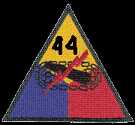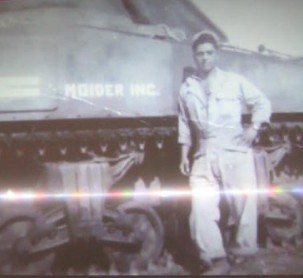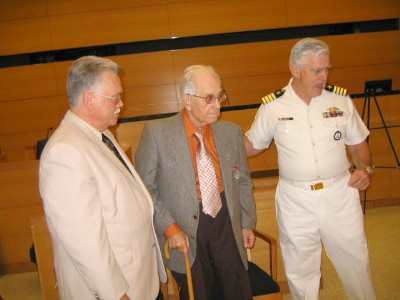|
MEMORIES OF A VETERAN - THE BATTLE OF MANILA
This article is a small attempt on the part of the writer to remind contemporary Americans
both of the valor and sacrifices of their fathers, sons, brothers and husbands in one of the most ferocious battles ever
fought by the United States Army. For whatever reasons, the European Theatre of Operations during World War II seems to have been well documented by the
wartime correspondents. However, this article seeks to recall the horrors of the Pacific Theatre of Operations.
The island hopping campaign by the US Navy and Marine Corps has been burned into the collective memories of the People of the United States. Who can forget Iwo Jima, Tarawa, Guadalcanal, Saipan, and other hard-fought island battles?
These battles involved jungle fighting on sparsely populated islands. While the Navy and Marine Corps were engaged in those fierce battles, the US Army was fighting across the much larger island of New Guinea.
That also was for the most part jungle fighting. It wasn’t until the US Army was liberating the Philippine Islands that it encountered the terror and horrific destruction of urban street fighting. The
Capital City of Manila, known before the war as “The Pearl of the Orient” for its beauty was to be the
scene of carnage that would rival the destruction of Warsaw and Stalingrad. The cruel massacre of 100,000 Filipino
men, women, and children by the Japanese during the battle can never be forgotten.
Recently, I was invited to an award ceremony to be held in Brooklyn Court.
The award was to be presented to a veteran of the Battle of Manila. It so happened that the veteran was also the father of Judge
Vincent M. Del Guidice, Judge of the Court of Claims, Supreme Court of the State of New York. With great pride, Judge Del Guidice watched as his father, fomerly Staff Sergeant Anthony Del Guidice, 44th Tank Battalion, US Army, was presented with the award in a courtroom of the Supreme Court.

Staff Sgt Anthony Del Guidice, Co. “A”, 44th Tank Battalion, US Army
 The 44th Tank Battalion
had been a part of the equally famous 12th Armored Division. The 44th originated as a Tennessee National Guard Unit and had trained at
Camp Campbell, Kentucky as the 44th Regiment, 12th Armored Division. On ll November 1943, 12th Armored Divsion was sent via troop train to Camp Barkeley near Abilene, Texas. On 7 March 1944, the 44th Tank Battalion was ordered to report as a unit to Portland, Oregon for embarkation to the Pacific Theatre of
Operations. They were officially detached from the 12th Armored Division. The Unit was comprised of 48 officers, 3 warrant officers, and 803 enlisted men under the command of Lieutenant Colonel Tom H. Ross. The Battalion consisted of a Headquarters Company, a Service Company, a Medical Attachment, and four tank companies, Company A, B,C, and D. The 44th Tank Battalion
had been a part of the equally famous 12th Armored Division. The 44th originated as a Tennessee National Guard Unit and had trained at
Camp Campbell, Kentucky as the 44th Regiment, 12th Armored Division. On ll November 1943, 12th Armored Divsion was sent via troop train to Camp Barkeley near Abilene, Texas. On 7 March 1944, the 44th Tank Battalion was ordered to report as a unit to Portland, Oregon for embarkation to the Pacific Theatre of
Operations. They were officially detached from the 12th Armored Division. The Unit was comprised of 48 officers, 3 warrant officers, and 803 enlisted men under the command of Lieutenant Colonel Tom H. Ross. The Battalion consisted of a Headquarters Company, a Service Company, a Medical Attachment, and four tank companies, Company A, B,C, and D.
On 22 March 1944, the 44th boarded a 10,000 ton freighter-transport ship the U.S.A.T. Kota Baroe, a Dutch vessel. They sailed for 51 days across the Pacific to New Guinea. The 44th Tank Battalion was the first tank battalion in the Southwest Pacific and the first tank battalion in General Walter Krueger’s Sixth Army
. All four tank companies saw action in close combat support with various infantry units on New Guinea and the many
islands off the coast. Names like Hollandia, Wadke Island, Nooemfor Island, Tome Dutch New Guinea and Sarmi are not familiar to the American people.
The soldiers of the 6th Infantry Divsion will not forget New Guinea and the fight for Hill 225
near the enemy held Maffin Airfield. Company “C” of the 44th Tank Battalion supported the 6th Division Infantrymen in this, one of the bloodiest battles of New Guinea.

Wartime Photo of infantrymen of the 6th Division Hill 225 New Guinea
Courtesy of 6th Infantry Division Website: http://www.6thinfantry.com
 The 6th Division
historians write: The 6th Division
historians write:
“Troops from Company F, 20th Infantry Regiment arrive to reinforce attack positions on Hill 225 on
June 22, 1944. This is in the area of Lone Tree Hill, Maffin Bay Here the 20th Infantry had alaready been the spearhead of what would later be referred to as “the bloodiest ten days in the entire New
Guinea Campaign.” During these ten days, the 6th Infantry Division suffered over 800 casualties to
take a coral hill honeycombed with pillboxes, fortifications, and caves, hiding 75 MM mountain guns and nearly
8,000 defenders. These defenders included the command of General Tagami, battle hardened from their Campaign
in China, and sworn to defend the Maffin Airdrome to the death. There are no recorded prisoners in the accounts of
this battle. To the 6th Division men who survivied, it was commonly recalled as ‘our ten days in hell’. “
http://www.6thinfantry.com/index.php?module=mGallery2&g2_itemId=4291
These were the types of combat operations in which the 44th Tank Battalion rendered close support for
infantry. Note in the photo above that the terrain was dense jungle.
 The 44th Tank Battalion supported other infantry units in operations on New Guinea
until the island was secured. The troops of the 44th had become seasoned combat veterans. They were now about to embark for the liberation of the Philippine Islands. Company “C” was still attached to the 6th Infantry Division on New Guinea
, while the rest of the 44th Tank Battalion was headed for the assault on the island of Leyte
in the Philippines. Companies A, B, and D, 44th Tank Battalion landed on Leyte
on October 20, 1944 with the troops of the 1st Cavalry Division. For Company “A:” of the 44th Tank Battalion
to which Sgt Del Guidice was attached, the battle for “Breakneck Ridge”
was a tough fight. The Commanding Officer of Company “A”, Captain J. P. VanWinkle was wounded in this action. Sergeant Del Guidice
and the crew of their M4 Sherman tank had named it “Moider, Inc” . The tank earned its name during this fight in which the
tankers were credited with 250 enemy killed in action. The 44th Tank Battalion supported other infantry units in operations on New Guinea
until the island was secured. The troops of the 44th had become seasoned combat veterans. They were now about to embark for the liberation of the Philippine Islands. Company “C” was still attached to the 6th Infantry Division on New Guinea
, while the rest of the 44th Tank Battalion was headed for the assault on the island of Leyte
in the Philippines. Companies A, B, and D, 44th Tank Battalion landed on Leyte
on October 20, 1944 with the troops of the 1st Cavalry Division. For Company “A:” of the 44th Tank Battalion
to which Sgt Del Guidice was attached, the battle for “Breakneck Ridge”
was a tough fight. The Commanding Officer of Company “A”, Captain J. P. VanWinkle was wounded in this action. Sergeant Del Guidice
and the crew of their M4 Sherman tank had named it “Moider, Inc” . The tank earned its name during this fight in which the
tankers were credited with 250 enemy killed in action.
 |
Cpl Anthony Del Guidice, Co “A” 44th Tank Bn
in front of his M4 Sherman Tank “Moider, Inc”
 When the First Cavalry Division
landed in the Philippines on the island of Leyte, the troops were in combat from October, 1944 to December, 1944. The infantrymen
needed tank support and the 44th Tank Battalion was given that task. After the defeat of the Japanese forces on Leyte
, the First Cavalry Division and the 44th Tank Battalion then landed on Luzon in January, 1945. Luzon is the largest island in the Philippines and the capital city of Manila was on that island. It was defended by the Japanese forces under the command of General Tomoyuki Yamashita
. The Japanese Commander had decided not to fight in Manila, but to withdraw his army to northern Luzon
. The reason for his decision was that a city of one million citizens was not to be defended and ordered that on the appearance of American forces, all Japanese troops were to be evacuated
and bridges and installations destroyed. However, this was not to be. The fate of the City of Manila, “The
Pearl of the Orient” was sealed when the Japanese Manila Naval Defense Force commanded by Rear
Admiral Iwabuchi Sanji elected to make Manila the battleground and to defend the city to the last man. When the First Cavalry Division
landed in the Philippines on the island of Leyte, the troops were in combat from October, 1944 to December, 1944. The infantrymen
needed tank support and the 44th Tank Battalion was given that task. After the defeat of the Japanese forces on Leyte
, the First Cavalry Division and the 44th Tank Battalion then landed on Luzon in January, 1945. Luzon is the largest island in the Philippines and the capital city of Manila was on that island. It was defended by the Japanese forces under the command of General Tomoyuki Yamashita
. The Japanese Commander had decided not to fight in Manila, but to withdraw his army to northern Luzon
. The reason for his decision was that a city of one million citizens was not to be defended and ordered that on the appearance of American forces, all Japanese troops were to be evacuated
and bridges and installations destroyed. However, this was not to be. The fate of the City of Manila, “The
Pearl of the Orient” was sealed when the Japanese Manila Naval Defense Force commanded by Rear
Admiral Iwabuchi Sanji elected to make Manila the battleground and to defend the city to the last man.

General Douglas MacArthur
was determined to rescue thousands of prisoners who were being held on the grounds of Santo Tomas University
. Almost 4,000 allied civilian prisoners including the American nurses who had been captured on Bataan
were being held on the campus of the university. Knowing the fanaticism of the Japanese leadership at that time, MacArthur
feared for the safety of the internees on the grounds of the University and also for the prisoners of war being held by the Japanese. He ordered what would be named the “Flying
Column” be formed to race to Manila to free the prisoners. On January 31, 1944, t he rescue operation was composed of three “serial” elements of the 1st Cavalry Division with support units including a 44th Tank
Battalion Company in each of the three “serial” elements.
 They would also be supported by the 37th Infantry Division
. The column would have to travel 100 miles inside enemy territory. The existing roads enabled the 1st Cavalry Division to quickly
cover ground. The race was between the 1st Cavalry Division with the 44th Tank Battalion and
the infantry of the 37th “Buck-eyes”. On February 3, 1944, the rescue column crossed the Manila City
limits and under heavy Japanese resistance took control of the Malacanan Palace known as the “White House of the Philippines”.
The tank crew of the M4 Sherman tank “Yankee”, Company “B”, 44 Tank Battalion
, had the honor of being the first tank to cross into Manila. Shortly thereafter, Company “B” 44th Tank Battalion
and the infantrymen fought their way to the walls of the University of Santo Tomas. The tank named “Battlin’ Basic”
broke through the outer wall. The Japanese threatened a large group of the prisoners unless they were allowed to leave for their own lines. After negotiating the release of the
prisoners, the Japanese left for their own lines, but were either killed or captured shortly thereafter. A total of 3,768 American and Allied civilians were rescued. They would also be supported by the 37th Infantry Division
. The column would have to travel 100 miles inside enemy territory. The existing roads enabled the 1st Cavalry Division to quickly
cover ground. The race was between the 1st Cavalry Division with the 44th Tank Battalion and
the infantry of the 37th “Buck-eyes”. On February 3, 1944, the rescue column crossed the Manila City
limits and under heavy Japanese resistance took control of the Malacanan Palace known as the “White House of the Philippines”.
The tank crew of the M4 Sherman tank “Yankee”, Company “B”, 44 Tank Battalion
, had the honor of being the first tank to cross into Manila. Shortly thereafter, Company “B” 44th Tank Battalion
and the infantrymen fought their way to the walls of the University of Santo Tomas. The tank named “Battlin’ Basic”
broke through the outer wall. The Japanese threatened a large group of the prisoners unless they were allowed to leave for their own lines. After negotiating the release of the
prisoners, the Japanese left for their own lines, but were either killed or captured shortly thereafter. A total of 3,768 American and Allied civilians were rescued.
The 44th Tank Battalion continued to support the 1st Cavalry Division in combat operations during the ferocious fighting in the City of Manila.
http://en.wikipedia.org/wiki/Battle_of_Manila_(1945)
http://en.wikipedia.org/wiki/Manila_Massacre
1945 NEWSREELS OF THE BATTLE THAT RIVALED STALINGRAD AND WARSAW
BATTLE OF MANILA NEWSREEL 1945
http://www.youtube.com/watch?v=jDx2dvTYizk
BATTLE OF MANILA OFFICIAL FILM 1945
http://www.youtube.com/watch?v=8R2dVPIL-2g
That contemporary newsreel shows the reality of urban warfare. The fate of the City of Manila, “The Pearl of the Orient”
was sealed when the Japanese Manila Naval Defense Force commanded by Rear Admiral Iwabuchi Sanji
elected to make Manila the battleground and to defend the city to the last man. Manila was virtually destroyed by the fighting. The 17,000 Japanese Manila Naval Defense Force was decimated, but the slaughter of 100,000 Filipinos
by those same Naval Forces was a monstrous war crime. Admiral Sanji perished
in the battle, but in all likelihood had he survived, he would have been executed as a war criminal. Ultimately, his commander, General Tomoyuki Yamashita, the so-called “Tiger of Malaya”
was held accountable for the battles in the Philippines and executed as a war criminal at the end of the war.
Memorare Memorial Manila erected 18 February 1995 Plaza de Santa Isabel, also known as the
Plaza Sinampalukan, located at the corner of General Luna and Anda Streets in Intramuros, Manila
"This memorial is dedicated to all those innocent victims of war, many of whom went nameless and unknown to a common grave, or even never knew a grave at all, their
bodies having been consumed by fire or crushed to dust beneath the rubble of ruins."
"Let this monument be the gravestone for each and every one of the over 100,000
men, women, children and infants killed in Manila during its battle of liberation, February 3 - March 3, 1945. We have not forgotten them, nor shall we ever forget."
"May they rest in peace as part now of the sacred ground of this city: the Manila of our affections."

Staff Sergeant Anthony Del Guidice
served with distinction during World War II with Company “A”, 44th Tank Battalion. He was wounded in battle during operations in New
Guinea, and also during the Philippines Campaign. He was awarded two purple hearts. He and his Unit were awarded four battle stars and the Philippine Liberation Medal. On April 11, 2007, He was awarded the
Conspicuous Service Cross of the State of New York. I attended the ceremony in the Brooklyn Court. Sgt Del Guidice
was presented the medal by US Navy Captain John Ingraham, USNR (Retired). It is a fitting tribute to a veteran of the Battle of Manila. The 44th Tank Battalion records list 147 men of the 44th Tank Battalion
as killed, wounded, or missing in action. The Unit had 15 tanks and one half-track destroyed in enemy action. Thirty two of those men would never return. The Commanding Officer, Lt. Colonel Ross
would be one of those killed in action.
After the surrender of the Japanese, a memoir of the combat record of the “44th Tank Battalion - Tank Tracks,
Tennessee to Tokyo” was published and kept by the troops of that Unit. The deeds of the tankers of the 44th Tank Battalion
is documented for historians in this small memoir.

LtoR: Judge Vincent Del Guidice, Sgt Anthony Del Guidice, Capt John Ingraham, USNR (Ret)
Staff Sergeant Anthony Del Guidice
at the award ceremony. Over 60 years have passed since the Battle of Manila. Yet, when Sgt Del Guidice
received the award, the memories of those wartime experiences and his fellow soldiers filled his eyes with tears.
CLICK HERE TO RETURN TO NY COP HOMEPAGE
|

